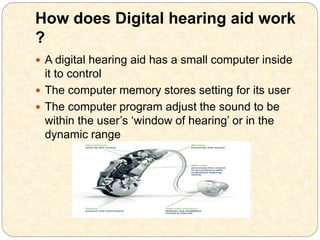Digital Hearing aid
- 1. Medical Application of DSP : DIGITAL HEARING AID Applications of Digital Signal Processing in Hearing aids
- 3. Working : ÔÇó The sound picked up by the microphone, is converted into an electric signal, and then digitized ÔÇó The digital signal is then filtered to selectively amplify those frequency bands in which the patient shows the most severe hearing loss ÔÇó Amplitude compression, in which the system gain is reduced when the amplitude exceeds some pre- defined threshold values, in order to avoid excessive loudness to the ear is also used. ÔÇó Finally the processed digital signal is converted back to analog form in the digital-to-analog (D/A) converter, and delivered to the ear via the earphone
- 4. Digital hearing aid :
- 5. ÔÇó In a further stage of signal processing in hearing aids, the amplitude-range may be compressed ÔÇó Hence, the gain of the system is progressively reduced when the sound-volume exceeds a specified level ÔÇó A small delay in adapting the gain to the signal- levels may also be added, as the average of the most recent amplitudes drives the gain control
- 6. How does Digital hearing aid work ?  A digital hearing aid has a small computer inside it to control  The computer memory stores setting for its user  The computer program adjust the sound to be within the user’s ‘window of hearing’ or in the dynamic range
- 7. What happens inside it? ÔÇó The speech spectrum is split into bits of data ; number which can be manipulated by the tiny computer ÔÇó Sound is then amplified to make them audible ÔÇó Extra algorithm may be programmed by the DSP unit for feedback control, noise reduction and sound enhancement






